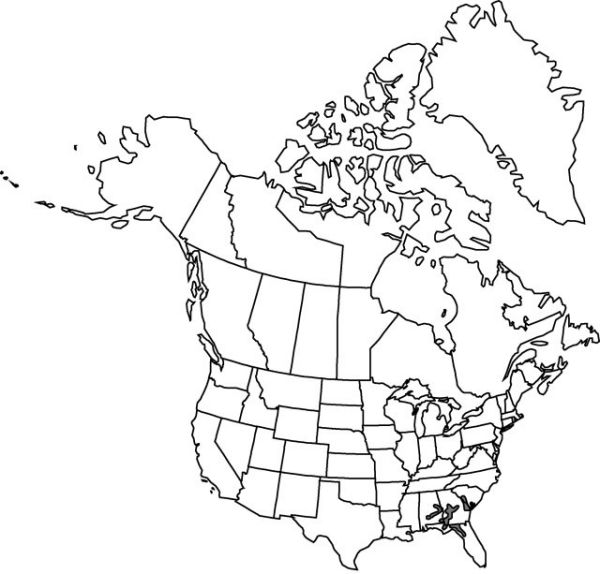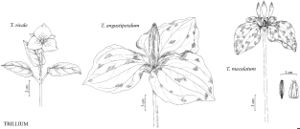Trillium maculatum
Med. Fl. 2: 103. 1830.
Rhizomes horizontal, brownish, short, thick, praemorse, not brittle. Scapes 1–3, round in cross section, 1.4–4 dm, slender to stout, glabrous. Bracts held well above ground, tips only touching ground in early anthesis, sessile; blade dark green, mottling darker, mottled to varying degrees, mottling becoming obscure with age, broadly ovate-elliptic to elliptic, 7–15 × 4.6–6.7 cm, not glossy, apex rounded or barely acuminate. Flower erect, odor faintly spicy and bananalike; sepals displayed above bracts, spreading almost to horizontal, often suffused or streaked with purple-maroon, lanceolate-linear, 22–50 × 5–7 mm, margins entire, apex rounded-acute, recurving slightly; petals long-lasting, spreading-erect, ± connivent, ± concealing stamens and ovary or sometimes slightly spreading early, only partially obscuring stamens, becoming more erect and even touching in the manner of Trillium cuneatum when older, clear dark red-maroon, or reddish purple, without muddy or brown tones of many purple sessile species, or, rarely, purple basally and yellow toward apex, or clear sulfur yellow, not spirally twisted, narrowly oblanceolate-spatulate to linear-spatulate, widest above middle, narrowing to apex, 4–7 × 0.7–1.7 cm, thick-textured, margins entire, slightly involute in proximal 1/2, apex acute to round-acute; stamens erect, 12–20 mm; filaments dark purple, 2–3 mm, widest at base, much shorter than anther sacs; anthers erect, straight, brownish purple, 10–16 mm, dehiscence introrse on broad connective; connectives brown-purple, straight, essentially not extended beyond anther sacs; ovary dark purple, ovoid, weakly 3-angled to smooth (rarely very obscurely 6-angled), angles often obscured in large, turgid ovary, 8–11 mm; stigmas erect, divergent-recurved, distinct, purplish, subulate, 2–4 mm, fleshy. Fruits dark purplish green, odor not reported, ovoid, obscurely 3- to 6-angled, bearing persistent stigma, 1 × 2 cm, pulpy.
Phenology: Flowering mid winter–early spring (early Feb–early Apr).
Habitat: Rich mesic forests, particularly banks and bluffs of rivers, floodplains, often where quite brushy, rich soils, calcareous soils, alluvium
Elevation: 0–500 m
Distribution

Ala., Fla., Ga., S.C.
Discussion
In their account of the Carolinas flora, A. E. Radford et al. (1968) did not treat Trillium maculatum or give any explanation of why they omitted this species, which is fairly widely distributed in southeastern South Carolina and morphologically is one of the more distinct sessile trilliums.
Many color forms occur and have been named. In forma luteum J. D. Freeman, for example, all floral organs lack purple pigment, and the petals are clear, soft yellow, whereas forma simulans J. D. Freeman has yellow petals with purple bases, and purple stamens and carpels. These are illustrated in color in F. W. Case and R. B. Case (1997).
Selected References
None.
